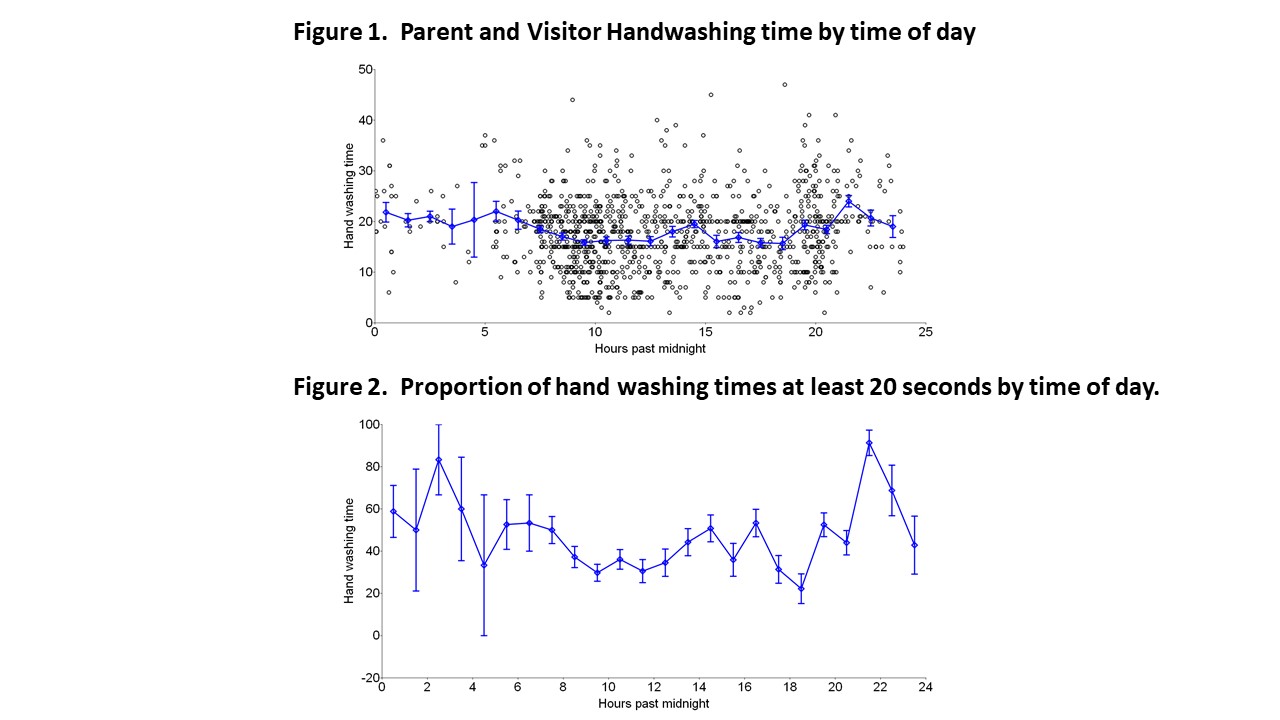Neonatal Infectious Diseases/Immunology
Category: Abstract Submission
Neonatal Infectious Diseases/Immunology: COVID-19
288 - Parent and Visitor Hand Hygiene Patterns in the NICU during COVID.
Saturday, April 23, 2022
3:30 PM - 6:00 PM US MT
Poster Number: 288
Publication Number: 288.226
Publication Number: 288.226
Nicole Post, University of Virginia School of Medicine, Herndon, VA, United States; David A. Kaufman, University of Virginia School of Medicine, Charlottesville, VA, United States; Mark R. Conaway, University of Virginia, Charlottesville, VA, United States

David A. Kaufman, MD
Professor of Pediatrics
University of Virginia School of Medicine
Charlottesville, Virginia, United States
Presenting Author(s)
Background: Hand hygiene (HH) is often singled out as the most important method in decreasing the incidence of hospital-acquired infections (HAIs). Most efforts have focused on health care workers, but not visitors. NICU patients represent a highly vulnerable patient group for HAIs from hand contact from parents and visitors due to a high frequency of patient contact in a 24-hour period, immature immune system, invasive procedures, and prolonged hospitalization. Parents and visitors may represent a source of neonatal pathogen acquisition and an opportunity to improve HH practices and potentially decrease HAIs.
Objective: The aim of this study was to determine baseline compliance and duration of handwashing(HW) prior to entering the NICU.
Design/Methods: An observational study was performed at the University of Virginia NICU, a 52 bed Level IV center. The visiting policy during the observation period was for 1-2 visitors per day. Staff observed and recorded the length of time that water was running while a visitor was washing their hands along with their apparent gender and time of the day.
Results: Over a 4-month period from 3/27/2020 to 7/13/2020 we observed 1112 visitors including 421 males and 689 females prior to NICU entry. Median(range) HW time was 18(2-47)sec with the average male(19±7sec) higher than female(17±7sec) times(Table and Fig1). Only 42% of observations were ≥20 sec with 47% of males compared with 38.8% of females observed meeting this metric (Table 2 & Fig 2). HH times were longer at night(8PM to 8AM)) compared to daytime(8AM to 8PM) by 3 sec (20±7 vs 17±7 sec, P < 0.001)(Table 2). Average HW time and proportion ≥20 sec increased by 2-3 sec and 12.5-14%, respectively from March to July (P < 0.001) (Fig 3).Conclusion(s): The average HW time was below the CDC recommended time of 20 sec and parents/visitors only achieving this goal 43% of the time. HW times were longer at night time possibly due to fewer people visiting at night and not feeling others needed to perform HW at the sink at the same time. HW times improved monthly possibly due to HH importance related to COVID or other factors. We only examined HH upon NICU entry and HH at the bedside is also critical. Interventions should be introduced in order to reach compliance with CDC guidelines including: signage at eye level & digital clock over sinks,& staff mentioning to visitors to “wash hands for at least 20 seconds.” We aim to evaluate the effectiveness of these interventions. We would like to acknowledge our data collection team: Mary Brobbey, Sade Fields, Tonya Jones, Marta Koo, Jennell Lynch, & Rochel Tyree.
Parent and Visitor Handwashing times (Table 1) and Proportion at least 20 seconds by time of day and month (Table 2)..jpg) There was a significant difference between times of day that is relatively consistent across months, with longer times at night time (20:00 to 8:00) compared to the daytime (8:00-20:00) time period. These differences are particularly large in the months May through July 2020. Logistic regression showed a significant interaction between time of day and month (p = 0.018)
There was a significant difference between times of day that is relatively consistent across months, with longer times at night time (20:00 to 8:00) compared to the daytime (8:00-20:00) time period. These differences are particularly large in the months May through July 2020. Logistic regression showed a significant interaction between time of day and month (p = 0.018)
Figure 1. Parent and Visitor Handwashing Time by Time of Day. Figure 2. Proportion of Handwashing times at least 20 seconds by time of day.
Objective: The aim of this study was to determine baseline compliance and duration of handwashing(HW) prior to entering the NICU.
Design/Methods: An observational study was performed at the University of Virginia NICU, a 52 bed Level IV center. The visiting policy during the observation period was for 1-2 visitors per day. Staff observed and recorded the length of time that water was running while a visitor was washing their hands along with their apparent gender and time of the day.
Results: Over a 4-month period from 3/27/2020 to 7/13/2020 we observed 1112 visitors including 421 males and 689 females prior to NICU entry. Median(range) HW time was 18(2-47)sec with the average male(19±7sec) higher than female(17±7sec) times(Table and Fig1). Only 42% of observations were ≥20 sec with 47% of males compared with 38.8% of females observed meeting this metric (Table 2 & Fig 2). HH times were longer at night(8PM to 8AM)) compared to daytime(8AM to 8PM) by 3 sec (20±7 vs 17±7 sec, P < 0.001)(Table 2). Average HW time and proportion ≥20 sec increased by 2-3 sec and 12.5-14%, respectively from March to July (P < 0.001) (Fig 3).Conclusion(s): The average HW time was below the CDC recommended time of 20 sec and parents/visitors only achieving this goal 43% of the time. HW times were longer at night time possibly due to fewer people visiting at night and not feeling others needed to perform HW at the sink at the same time. HW times improved monthly possibly due to HH importance related to COVID or other factors. We only examined HH upon NICU entry and HH at the bedside is also critical. Interventions should be introduced in order to reach compliance with CDC guidelines including: signage at eye level & digital clock over sinks,& staff mentioning to visitors to “wash hands for at least 20 seconds.” We aim to evaluate the effectiveness of these interventions. We would like to acknowledge our data collection team: Mary Brobbey, Sade Fields, Tonya Jones, Marta Koo, Jennell Lynch, & Rochel Tyree.
Parent and Visitor Handwashing times (Table 1) and Proportion at least 20 seconds by time of day and month (Table 2).
.jpg) There was a significant difference between times of day that is relatively consistent across months, with longer times at night time (20:00 to 8:00) compared to the daytime (8:00-20:00) time period. These differences are particularly large in the months May through July 2020. Logistic regression showed a significant interaction between time of day and month (p = 0.018)
There was a significant difference between times of day that is relatively consistent across months, with longer times at night time (20:00 to 8:00) compared to the daytime (8:00-20:00) time period. These differences are particularly large in the months May through July 2020. Logistic regression showed a significant interaction between time of day and month (p = 0.018)Figure 1. Parent and Visitor Handwashing Time by Time of Day. Figure 2. Proportion of Handwashing times at least 20 seconds by time of day.

